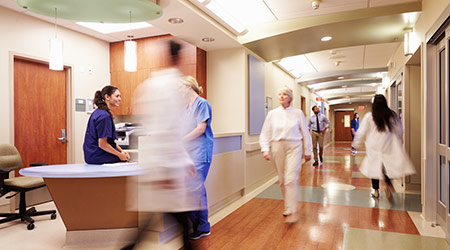Q: If an inpatient in a hospital (healthcare occupancy) is taken into a building that is not a healthcare occupancy for say CT or MRI, does this building have to then meet the requirements in the Life Safety Code for a healthcare occupancy?
A: Perhaps… According to section 19.1.3.4.2 of the 2012 LSC, it says ambulatory care facilities, medical clinics, and similar facilities that are contiguous to healthcare occupancies shall be permitted to be used for diagnostic and treatment services of inpatients who are capable of self preservation. This is new for the 2012 LSC and was not found in the 2000 edition, so not everyone may be aware of this. But the kicker is “inpatients who are capable of self-preservation”.
The inpatient really does need to be capable of taking action for their own self-preservation without the assistance of others. To compound this further, CMS issued a correction to their Final Rule to adopt the 2012 Life Safety Code on June 30, 2016, that specifically says any facility that qualifies as an ambulatory healthcare occupancy (AHCO) must meet the requirements for AHCO regardless of the number of patients served. So, that means the MRI and possibly the CT units would have to qualify as AHCO because patients are often strapped into the unit and are not capable of self-preservation.
All healthcare occupancy inpatients, even if it is just one inpatient, that are brought into a contiguous facility that is not a healthcare occupancy for diagnostic or treatment purposes must be capable of self-preservation. Otherwise, it is not permitted.
Brad Keyes, CHSP, is the owner of KEYES Life Safety Compliance, and his expertise is in the management of the Life Safety Program, including the Environment of Care and Emergency Management programs.

 UF Health Hospitals Rely on Green Globes to Realize Their Full Potential
UF Health Hospitals Rely on Green Globes to Realize Their Full Potential How Healthcare Facilities Can Be Truly Disaster-Resilient
How Healthcare Facilities Can Be Truly Disaster-Resilient TriasMD Breaks Ground on DISC Surgery Center for San Fernando Valley
TriasMD Breaks Ground on DISC Surgery Center for San Fernando Valley Bigfork Valley Hospital Falls Victim to Data Breach
Bigfork Valley Hospital Falls Victim to Data Breach AI-Driven Facilities: Strategic Planning and Cost Management
AI-Driven Facilities: Strategic Planning and Cost Management